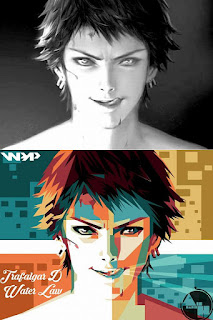What is WPAP ?
WPAP an abbreviation from Wedha's Pop Art Portrait is made by Mr.Wedha from Indonesia.
Wedha, originally from Indonesia, created his art work in traditional mediums early in the 1990s, which later in early 2000, crossed over into the digital world. Vector being the natural choice for such a colorful, geometric style.
Since then, it has gained major popularity in Indonesia, with several communities dedicated to the creation and showcasing of portraits in a WPAP style, with members in their thousands! With the resurgence of the geometric trend, it's fair to say that WPAP may venture out of Indonesia and into more aspects of design.
The following is a tutorial on how to create a WPAP (Wedha's Pop Art Portrait) portrait in Adobe Illustrator, by the WPAP master himself!
By the way, although there's no shortcut to creating Wedha's exact WPAP style, you can apply some wonderful effects to portraits in a single click with Geometric Pop Art, a Photoshop action available on Envato Market for just $4.Or if you're looking for something more customized, you can hire an Envato Studio designer to create a vector portrait for you based on your photograph.
1. An Introduction to the WPAP Process
WPAP's main goal is to represent the faces that are already familiar to us, with a new and different style, but it still must be easily recognizable. Different in a sense of being more unique, more dynamic, more striking and of course, more visually pleasing to see, I hope.With that in mind, the WPAP creative process is based on two main processes; the faceting process and the coloring process. I do these two processes simultaneously when creating a new portrait.
The Faceting Process
In the faceting process, by tracing the image, I divide the human face into facets. Every facet (plane) is formed based on the different degrees of dark and bright areas seen on theoriginal photo. Every facet is formed by straight lines, instead of curved lines. This is because facets that are formed by straight lines will appear stronger than a facet formed by curved lines.
Before we start the process, we should begin to see and assume the face of a human being as a shape that consists of many flat surfaces on a sphere, just like the ball in the below image. This is how best to describe the faceting process.
The Coloring Process
 In coloring, to show something stronger, I only use flat colors, instead of a gradual colors. Although the colors look as if they collide with each other, effort should be made to make it look three-dimensional.
In coloring, to show something stronger, I only use flat colors, instead of a gradual colors. Although the colors look as if they collide with each other, effort should be made to make it look three-dimensional. Creative experts will classify colors in groups. You have groups of hot colors, warm colors, cold colors. Think of them in terms of dark and light colors, ignoring the actual hue. Think more of colors in highlights, mid-tones and shadow. The differences in these groups make it possible for us to make a dimensional composition. No matter what color you choose, as long as you pick it from the right group, the result should work well in this format. Therefore it is important to experiment with color.




Comments
Post a Comment